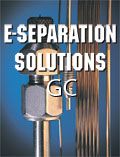GC Technology Forum
Gas chromatography (GC) continues to be a workhorse technique in the analytical laboratory, but users now face choices of upgrading their systems to newer time-saving technologies or possibly switching to hydrogen carrier gas. Participants in this Technology Forum are Eric Denoyer and Rebecca Veeneman of Agilent Technologies, Jim Luong of Dow Chemical Canada, and Matthew S. Klee of JAS Inc.
Gas chromatography (GC) continues to be a workhorse technique in the analytical laboratory, but users now face choices of upgrading their systems to newer time-saving technologies or possibly switching to hydrogen carrier gas. Participants in this Technology Forum are Eric Denoyer and Rebecca Veeneman of Agilent Technologies, Jim Luong of Dow Chemical Canada, and Matthew S. Klee of JAS Inc.
Will the aging and replacement of older instruments cause labs to adopt newer, more costly (but time-saving) methodologies and technologies — such as open-tubular columns as packed column replacements, portable GC systems, fast GC, or automated robotic sample handling — or will labs simply replace their systems with similar less costly instruments? What standardizations and regulations would help drive the upgrade process?
Denoyer and Veeneman: More and more, we do see the adoption of newer technologies over just opting for lower cost solutions. The extent to which new technology is adopted during the replacement cycle depends on the extent to which the new technology disrupts workflow or deviates from the lab’s validated methodology. The prospect of developing new methods, or even revalidating exiting methods, can sometimes disturb a business process enough to offset the potential advantages of time savings in the mind of the lab manager. But nowadays, lab managers are applying more business savvy and justifying initial investment by looking at total cost of ownership and productivity. This includes the initial capital investment, method validation or development, consumables and operating costs, and importantly, the ability to deploy human resources better. We are getting more and more requests, for example, for our cost‐of‐ownership calculators that can help lab managers justify the adoption of new technology in their specific lab situation.
Regulations that prescribe highly specific methods and techniques can slow new technology adoption. So we often see new technologies adopted faster in jurisdictions that accommodate performance‐based methods.
Luong: Some of the key drivers for replacing obsolete equipments are reliability, enhanced performance, and ease-of-use. New innovations in chromatography afford more difficult and challenging applications to be conducted. Applications that were deemed impossible with previous generations of hardware can be conducted reliably and effectively with contemporary commercially available product offerings.
With a few exceptions, instrument manufacturers are doing a great job in ensuring that enhanced performance with advanced technologies is within the model of affordability of end-users.
Klee: I divide the GC replacement market into two broad categories: routine and R&D. Routine labs typically do not replace instruments that are working. The instruments perform methods that were developed and validated on them (so features and performance are not issues) and the labs have limited capital budgets. It is quite difficult for routine labs to justify replacements even if there are potential benefits and payback periods of

.png&w=3840&q=75)

.png&w=3840&q=75)



.png&w=3840&q=75)



.png&w=3840&q=75)






